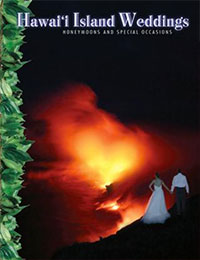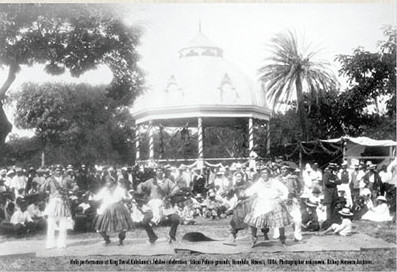Feeling the Touch of Aloha with Aunty Tutu
 The rich, deep tones resounding forth from a conch shell announce the beginning of the ceremony—like the first strains of “Here Comes the Bride,”
The rich, deep tones resounding forth from a conch shell announce the beginning of the ceremony—like the first strains of “Here Comes the Bride,”
or the ringing of a church bell. This is the Hawaiian way, with the pū (conch
shell), being wielded by the officiant herself. She chants a Hawaiian welcome, picks up her ‘ukulele and smiles sweetly as she begins to serenade the bride and groom with a traditional song, “I Love You,” or another melody of the couple’s choosing. This is the “Aunty Tutu way,” as the lucky bride and groom enter into an enchanted space created as if in a magical dream world.
Although she has created the persona of Aunty Tutu for this stage in her life, the name belies the force of nature that is this wahine, whose given name is Stephanie Lindsey. Perhaps others who hear that name (also, “Aunty Steph”), can recall when she was once the executive director and emcee of the famous Germaine’s Luau on O‘ahu back in the day, or that she was part of the Mauna
Kea Beach Hotel’s Tahitian show. They might recognize her as the big sister of Leabert Lindsey, famous Hawaiian singer/entertainer, and their equally talented brother, Kaleo Lindsey. Her family genealogy contains a string of famous ancestors, including her great-grandfather on her mother’s side, entertainment impresario E.K. Fernandez and on her father’s side, Hawai‘i Island rancher and great-grandfather, James Fay Lindsey, Sr. Her family were kumu hula and hula dancers, all the way back to her great grandmother, Minerva Fernandez, who was the lady-in-waiting to Queen Lili‘uokalani. Lindsey can even trace her genealogy as far back as the origins of Hawaiians in oral history tradition. At the Haleo Lū‘au, an Island Breeze production at the Sheraton Kona Resort & Spa at Keauhou Bay, you will see her at center stage as the emcee and orchestrator of one of Kona’s most popular lū‘au events. She works closely with the hotel as their Ambassador of Aloha and Cultural Kupuna.

“I tell the hotel, you need your kūpuna to be successful. They bind you to the land” she proclaims.
Aunty Tutu walks among the gods as she strolls through the grounds of the Sheraton, greeting guests as if they were long-lost friends, spreading so much aloha it catches them off-guard, their faces lit up with a smile as they walk away from this chance encounter. She lives the persona of Aunty Tutu, not just in her ceremonies or while on stage, but at all times.
Let us not digress, however, as the wedding ceremony is about to continue. Oh, wait—we have to step backward in time once more to Aunty’s preparation of the sacred ground upon which the couple and their family will gather. She has visited it in advance to pray and bless the space, removing not only stray leavings of others but old energies that may have been inadvertently left by some troubled person walking there. Being Hawaiian, she incorporates her cultural beliefs and protocol into her ceremonies. As she stands there, she imagines in her mind the setting with the ceremony taking place: which way the light falls so the photographer gets the best shot or which way the wind will be blowing so the bride’s hair falls just so and doesn’t hide her eyes as they gaze upon her beloved.
We then backtrack a few more days or weeks to her first conversation with the bride and groom, either on the phone or in person, as they became acquainted. Aunty Tutu listens to her own heart and to the couple’s vision of the wedding. What are their colors? That determines what the kahu (minister) will wear. Her traditional Hawaiian mu‘umu‘u must not be too flashy and must coordinate. She wears a small, ministerial-looking, lace-trimmed cape overlaying her bosom and shoulders. She affectionately calls it a “bosom buddy” and chooses one from different coordinating colors.
“We talk story and email back and forth,” Aunty says. “I say, ‘How are you wearing your hair?’ and make suggestions that will put her in the best light. The bride always gets the last word,” she adds. One of the famous Lindsey brothers may also be suggested for additional music.
The ceremony site has been chosen from among several possibilities, perhaps on the grounds of the hotel where a wedding planner has assisted in putting together a package, or perhaps it’s at another private or public space with which
Aunty is familiar. She is one of the kahu referred for weddings by the Sheraton Kona Resort & Spa, the Hilton Waikoloa Village, King Kamehameha’s Kona Beach Hotel and Lava Lava Beach Club, as well as through direct contact or referrals.
“‘Can you send me your ceremony?’ they ask me. I say no, because it changes by your history, the story you’re telling me, and what I’m feeling at the time,” says Aunty.
What do the couple plan to say to each other? Do they have vows or statements already written? Do they plan to whip out cellphones to read?
“Oh, no,” she responds. “They must not do that.”
She will help them print their vows on parchment and wrap it around a bamboo staff tied with raffia, which they can then unroll and read.
“I love this part of the ceremony,” she says. “I tell the couple I will allow the time for your family to stand up and give you blessings. I will then ask if they have anything to say to each other. They can read what they’ve written or just share.” Each detail and moment is envisioned. As they get acquainted, Aunty learns more about the family and friends who may attend and what sensitivities there may be. If there is someone who cannot attend but who is in their hearts, she even prepares a candle to represent that one.
There are more surprises to come.
The day arrives, and you find that Aunty Tutu has also arranged the guests. This “Impresario of Lū‘au” knows staging and knows her audience! The bride’s family and friends—opposing tradition—is placed on the opposite side, where they can see her face instead of the back of her head as she gazes at her husband-to-be. The groom’s retinue, as well, is on the side usually reserved for the bride’s friends, where they, too, can see his face as he looks lovingly upon his new bride. Aunty has told the photographer, either professional or amateur, that she intends to stand to the side rather than in the middle, so as not to be the center of attention in photos of the ceremony. No worries: she is right next to the groom’s shoulder.
As the melody of “I Love You” begins, the bride lays down the umbrella that until this time has been shielding her face, and the light appears in the eyes of the groom as he first sees her. Everyone steps into place.
Aunty Tutu has no script, she says. She has but an outline of the proceeding, as she lets the spirit move her. Everything that she says is genuine and from the heart, created in the moment for only this day and for only this time.
She conducts a traditional Hawaiian blessing of the couple with a ti leaf dipped in ocean water. “I say that, spiritually, we Hawaiians believe that our Pacific Ocean touches every part of the world through many currents,” she says.
Another feature is the lantern that holds a candle with two wicks, which signifies someone like a grandparent. “‘This candle stands for all those who can’t be here,’ I say. If there are more, I suggest they bring a candle for them and ask them if they would you like to bring a picture,” Aunty explains.
Two leis are included, one for each to wear. Yet, there is a third one as well.
“I always make a ti leaf lei for draping on my calabash, then I gift it to them to hang it over their doorway at home,” says Aunty. “I’m constantly gifting them with things to take home. I love the thought that that’s what they’re doing.”
A very special signature piece of the ceremony is the preparation and creation of the jar of sands. A small, clear glass container that fits into the palm of the hand has been prepared. In the bottom is a layer of pure, shining black lava crystals that Aunty has collected from a secret place at the top of the volcano. Next is a layer of pure white sand, representing the bride, who pours it on top of the lava layer. After that, the groom adds his layer of colored sand, perhaps blue. In succeeding layers are placed sand from children of the bride or groom, a last bit of sand from the site of the ceremony, a scrap of ancient kapa cloth once owned by royalty, a pinch of pa‘akai, (Hawaiian salt), petals from everyone’s lei, a piece of ti leaf that was used in the water blessing, and a silk flower petal on top. At the end of the ceremony, as photos are being taken and everyone is congratulating the bride and groom, Aunty glues the glass top onto the jar and ties a bow of raffia around it. She presents it to the couple as a makana (gift) and souvenir of their union.
At the end of the ceremony, Aunty once again picks up her ‘ukulele and plays, “The Hawaiian Wedding Song,” as she invites the couple to dance. Perhaps the sky has lit up with a famous Kona sunset glow, or it has risen above Hualālai mountain if the ceremony has taken place at sunrise (not too many choose that time!). Palm trees are silent witnesses and, in Hawaiian beliefs and culture, the stones will remember this day.
Aunty says, “I tell them they are now ‘ohana and to stay in touch with me after they go home. I remind them that they have an aunty here in Hawai‘i. Please stay in touch. And they do!”
Fittingly, Aunty Tutu’s company is Feel the Touch of Aloha. She also performs blessings and renewal of vows, as well as teaching, choreography, and emcee duties drawn from her years in the entertainment business. She says she often does five weddings and two lū‘au in a week. On Tuesdays you can find her entertaining with her brother, Kaleo, at Wyndham’s Kona Hawaiian Resort
Aloha Party.
Aunty Tutu, (Stephanie Lindsey), grew up on O‘ahu, where her mother was a hula dancer who once greeted the Lurline ocean liners, as well as being a bartender for Don Ho. Her father’s family history dates back to the beginning of Parker Ranch, where his grandfather, James Fay Lindsey, was instrumental in founding a large family clan. She attended Kamehameha Schools in Kapālama, where she was student body president. After graduation, she worked in the travel industry and sang in Al Harrington’s Tapa Room show at the Hilton Hawaiian Village. She then moved to Hawai‘i Island in the 1970s, opening a hālau and helping the Mauna Kea Resort start up their Tahitian show. After about five years, she says, she traveled back to O‘ahu to work for Germaine’s for 21 years. She later returned to Hawai‘i Island to be with her brothers and to finally stay. As Aunty Tutu, she began doing weddings in 2014, with the major help and assistance of her husband, “number last”, Lopaka.
“He schedules for me,” says Aunty. “I would not do what I do today without this husband in my life.”
Contact Aunty Tutu: feelthetouchofaloha@gmail.com
Photos courtesy Feel The Touch of Aloha, LLC.
Contact writer Karen Valentine: karenvalentine808@gmail.com
